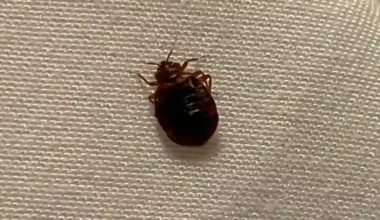Bed bug interceptors not working? Now is the time you fix it and get it to work! So, we have recently completed a third treatment for a mild bed bug infestation mainly confined to one room. Out of the three individuals in the house, only one person experienced bites even though we have been extremely vigilant in taking all necessary post-treatment precautions, including the use of bed bug interceptors.
Interestingly, we could not find any bed bugs in the interceptors that we set up to prevent them from climbing up the bedposts or descending from them. We also purchased a smaller comforter that does not touch the ground and moved the bed away from the wall to prevent access points for the bedbugs. Still, interceptors won’t work.
Well, that’s history now, and I’m confident it could be your history too…
Bed bug interceptors not working

For bed bug interceptors not working, do these:
1. Bed bugs are falling off the ceiling
What material is the ceiling made of? Our attempt to keep bedbugs from crawling up the bedposts resulted in them falling from the ceiling. Bed bugs have been known to climb on the ceiling and drop down onto the bed.
2. You have them on your bed frame
Additionally, bed bugs may be residing on or within the bed frame, quilt, mattress, or pillows. Therefore, since the bed frame is a major breeding ground for bedbug infestations, you want to check that out which could be the reason for bed bug interceptors not working.
3. Bed bug is in the corner of the box spring encasement
I discovered a bedbug concealed in the corner of the box spring encasement. It is likely that they are present on your bed in some of the areas.
4. Wrong interceptor installation
Improper installation can render an interceptor ineffective. It is important to check for any small gaps or cracks that bed bugs could potentially enter through, and ensure that there are no significant gaps surrounding the legs of any furniture placed on top of an interceptor. It is also essential to clean and change out the interceptor tray regularly, as the accumulation of debris can provide bed bugs with a safe haven. Scrubbing the interceptor down with soapy water frequently is recommended. Additionally, standing water should be avoided as it can provide pests with a place to live and avoid being trapped by your device.
5. Replace your mattress
Although interceptors are a useful tool for preventing infestations, they may not always be completely reliable depending on your situation of bed bug interceptors not working. If all other attempts to eliminate bedbugs fail, it may be necessary to replace your mattress, particularly if it has been severely infested. This can help to eradicate most (if not all) of the adult bedbugs that are living in or near it.
Also, get high-quality bed sheets and pillowcases that protect your mattress.
Note:
The rough surface on a bedbug interceptor is designed to allow bed bugs to crawl in easily, as they are not able to grip surfaces with their legs. However, the smooth and slippery surface inside the interceptor makes it difficult for bed bugs to climb out of the trap once they become stuck. As a result, bed bugs are effectively trapped and unable to escape interceptors.
How to use bed bug interceptors

Use your interceptors properly by doing these:
1. Shift your bed away from the wall and keep your sheets off the floor
When using interceptors, eliminate any other possible paths that bedbugs may use to bypass your traps. Ensure that the only way for bedbugs to access your bed is by climbing through the interceptors first.
2. Use multiple interceptor dishes
You need an interceptor under each leg of the bed frame, so do not rely on just one or two. You can also place interceptors under the legs of other upholstered furniture items in rooms where you suspect bedbugs, such as chairs or sofas.
3. Check the interceptors regularly
Since bed bugs typically emerge at night to feed, inspect the interceptors in the morning to determine if any bed bugs were trapped overnight. Monitor the traps consistently for at least 1 to 2 weeks to ensure that bedbugs are being effectively trapped and eliminated.
Contact a bed bug exterminator
If all else fails, and you still have bed bug bites despite using bed bug interceptors, contact your exterminator or local pest control company. You need a professional inspection to determine the location where the bed bugs are hiding and develop an effective plan to eliminate them.
Final thoughts on bed bug interceptors not working
Even with three different sprays, the bedbug may reappear. So, you don’t even have to replace both the mattress and the bed frame, as you could still experience bites every 5 days or so if you don’t properly eliminate all bed bugs. That often means you have only a few bugs remaining, but can’t seem to locate their hiding spot. Even with a canine inspection, the dog can only detect larger infestations. The overall solution, bed bugs are just somewhere in the room and not necessarily in the bed. Find and eliminate them — that’ll do.





